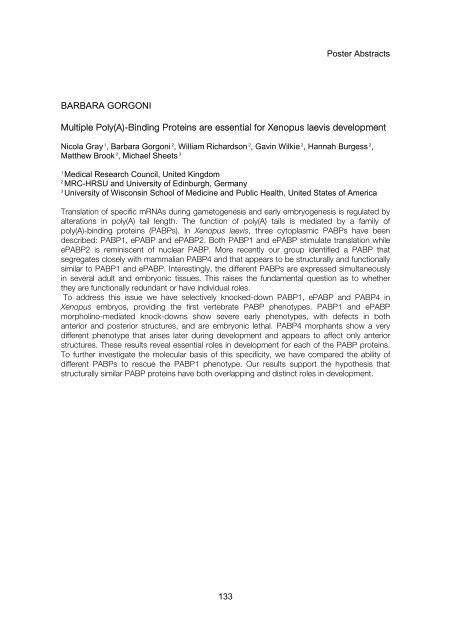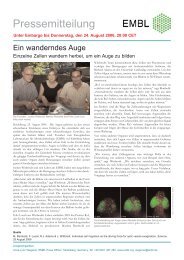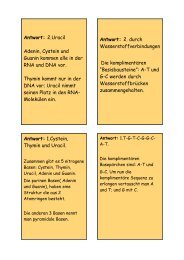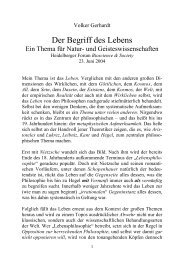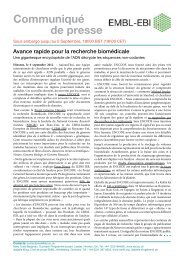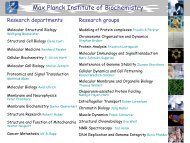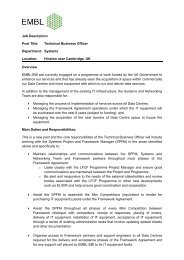EMBO Conference on Protein Synthesis and Translational Control
EMBO Conference on Protein Synthesis and Translational Control
EMBO Conference on Protein Synthesis and Translational Control
Create successful ePaper yourself
Turn your PDF publications into a flip-book with our unique Google optimized e-Paper software.
BARBARA GORGONI<br />
133<br />
Poster Abstracts<br />
Multiple Poly(A)-Binding <strong>Protein</strong>s are essential for Xenopus laevis development<br />
Nicola Gray 1, Barbara Gorg<strong>on</strong>i 2, William Richards<strong>on</strong> 2, Gavin Wilkie 2, Hannah Burgess 2,<br />
Matthew Brook 2, Michael Sheets 3<br />
1 Medical Research Council, United Kingdom<br />
2 MRC-HRSU <strong>and</strong> University of Edinburgh, Germany<br />
3 University of Wisc<strong>on</strong>sin School of Medicine <strong>and</strong> Public Health, United States of America<br />
Translati<strong>on</strong> of specific mRNAs during gametogenesis <strong>and</strong> early embryogenesis is regulated by<br />
alterati<strong>on</strong>s in poly(A) tail length. The functi<strong>on</strong> of poly(A) tails is mediated by a family of<br />
poly(A)-binding proteins (PABPs). In Xenopus laevis, three cytoplasmic PABPs have been<br />
described: PABP1, ePABP <strong>and</strong> ePABP2. Both PABP1 <strong>and</strong> ePABP stimulate translati<strong>on</strong> while<br />
ePABP2 is reminiscent of nuclear PABP. More recently our group identified a PABP that<br />
segregates closely with mammalian PABP4 <strong>and</strong> that appears to be structurally <strong>and</strong> functi<strong>on</strong>ally<br />
similar to PABP1 <strong>and</strong> ePABP. Interestingly, the different PABPs are expressed simultaneously<br />
in several adult <strong>and</strong> embry<strong>on</strong>ic tissues. This raises the fundamental questi<strong>on</strong> as to whether<br />
they are functi<strong>on</strong>ally redundant or have individual roles.<br />
To address this issue we have selectively knocked-down PABP1, ePABP <strong>and</strong> PABP4 in<br />
Xenopus embryos, providing the first vertebrate PABP phenotypes. PABP1 <strong>and</strong> ePABP<br />
morpholino-mediated knock-downs show severe early phenotypes, with defects in both<br />
anterior <strong>and</strong> posterior structures, <strong>and</strong> are embry<strong>on</strong>ic lethal. PABP4 morphants show a very<br />
different phenotype that arises later during development <strong>and</strong> appears to affect <strong>on</strong>ly anterior<br />
structures. These results reveal essential roles in development for each of the PABP proteins.<br />
To further investigate the molecular basis of this specificity, we have compared the ability of<br />
different PABPs to rescue the PABP1 phenotype. Our results support the hypothesis that<br />
structurally similar PABP proteins have both overlapping <strong>and</strong> distinct roles in development.


